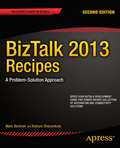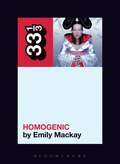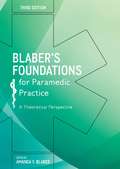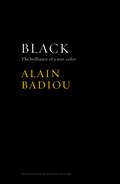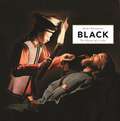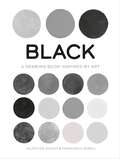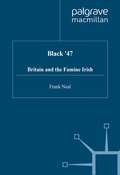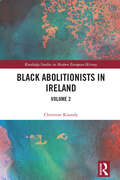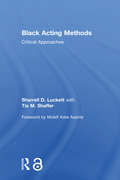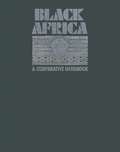- Table View
- List View
BizTalk 2013 EDI for Supply Chain Management: Working with Invoices, Purchase Orders and Related Document Types
by Mark BecknerBuilding a successful supply chain processing EDI implementation in BizTalk Server can be complex. Decisions must be made around how to extract and publish data, how to map to the various EDI standards, and how to appropriately batch and deliver data. If architected properly, your BizTalk solution can be highly efficient, simple, and something that can be managed and extended for years to come. The topics in this book include building complete inbound and outbound solutions for 810, 845, and 850 EDI document types, which will lay the groundwork for any document type you may be implementing. In addition, topics on how to set up FTP, SFTP, and AS2 protocols for document exchange, working with 997/999 acknowledgements, and creating custom applications for archiving and monitoring data are included. Covering mapping, architectural patterns, orchestrations, trading partner configurations, AS2, SFTP, FTP, usage of role links, and data routing, you will find that BizTalk 2013 EDI for Supply Chain Management gives you the detail and knowledge needed for success with your own implementations.
BizTalk 2013 Recipes: A Problem-Solution Approach
by Mark Beckner Kishore DharanikotaBizTalk 2013 Recipes provides ready-made solutions to BizTalk Server 2013 developers. The recipes in the book save you the effort of developing your own solutions to common problems that have been solved many times over. The solutions demonstrate sound practice, the result of hard-earned wisdom by those who have gone before. Presented in a step-by-step format with clear code examples and explanations, the solutions in BizTalk 2013 Recipes help you take advantage of new features and deeper capabilities in BizTalk Server 2013. You’ll learn to integrate your solutions with the cloud, configure BizTalk on Azure, work with electronic data interchange (EDI), and deploy the growing range of adapters for integrating with the different systems and technologies that you will encounter. You’ll find recipes covering all the core areas: schemas, maps, orchestrations, messaging and more. BizTalk Server 2013 is Microsoft’s market-leading platform for orchestrating process flow across disparate applications. BizTalk 2013 Recipes is your key to unlocking the full power of that platform.
BizTalk Server 2002 Design and Implementation
by Xin ChenChen's book provides everything developers need to know to build an end-to-end BizTalk solution, with focus on BizTalk Server 2002.
BizTalk Server 2010 Cookbook
by Steef-Jan WiggersThis book will explain step-by-step in each recipe how to, for example, implement a certain orchestration pattern, test a BizTalk artifact, monitor BizTalk with a third party tool, or secure a message. The recipes in this book are easy to understand and follow as the author discusses real-world scenarios. The range of topics covered in this book will bring out the forward-thinking BizTalk developer in you. The examples are supported by relevant background information for ease of understanding. This book is for professional BizTalk Developers and administrators to take their skills to the next level and explore the numerous capabilities BizTalk has. This book assumes that you have a basic understanding of BizTalk and SOA and BPM concepts.
BizTalk Server 2016: Performance Tuning and Optimization
by Agustín MántarasGain an in depth view of optimizing the performance of BizTalk Server. This book provides best practices and techniques for improving development of high mission critical solutions. You'll see how the BizTalk Server engine works and how to proactively detect and remedy potential bottlenecks before they occur.The book starts with an overview of the BizTalk Server internal mechanisms that will help you understand the optimizations detailed throughout the book. You'll then see how the mechanisms can be applied to a BizTalk Server environment to improve low and high latency throughput scenarios. A section on testing BizTalk server solutions will guide you through the most frequently adopted techniques used to develop solutions such as performance and unit testing as part of the development cycle. With BizTalk Server 2016 you'll see how to apply side-by-side versioning to your solutions to reduce the chances of downtime, You'll also review instrumentation techniques using Event Traces for windows and business activity monitoring (BAM). While the book is focused on the latest version of BizTalk Server, most of the topics discussed will also work with BizTalk Server 2013R2. What You'll LearnReview BizTalk Server internals and how the message engine worksUnderstand BizTalk Server architectureGather and analyze BizTalk Server performance data Develop BizTalk Server performance solutions Use advanced troubleshooting tools to help diagnose your platformWho This Book Is ForThose who have strong BizTalk and .NET Framework knowledge and want to get their BizTalk Server knowledge to the next level
Bjork & Bjork’s Desirable Difficulties in Action
by Isaac Moore Jade PearceThe concept of desirable difficulties is central to many of the evidence-informed strategies - such as spaced practice, retrieval practice and interleaving - that have become so prevalent in recent years, and so are one of the most crucial building blocks of cognitive science. Based on the finding that instruction and tasks most effective for long-term learning often hamper short-term performance, they are also one of the most counter-intuitive.In their seminal work, Elizabeth and Robert Bjork identified four desirable difficulties - so called because they improve long-term retention and transfer while making learning seem more challenging - including varying the conditions of practice, spacing, interleaving and practice testing.Isaac Moore and Jade Pearce build on this, explaining each strategy in detail including a summary of the research evidence that supports each difficulty, how it might look in the classroom and how it might be implemented with the greatest impact. They also discuss why students often fail to use these strategies in their independent study (despite their effectiveness) and how teachers and school leaders may encourage students to use them more. Succinct summaries and case studies from a range of practitioners will enable all readers to utilise desirable difficulties in their own classrooms and beyond.
Björk's Homogenic (33 1/3)
by Emily MackayIn recent years, Björk's artistry has become ever more ambitious and ever more respected. With the release of her conceptual app-album Biophilia in 2011, and a huge retrospective exhibition at New York's Museum of Modern Art coinciding with her most recent album, Vulnicura, in 2015, her status as artpop auteur has been secured. The album that made all this possible, though is 1997's Homogenic, a turning point in Björk's career and still among her finest musical achievements. Produced under great strain, it moves beyond the stylistic magpie rush of Debut and the urbanophile future-pop of Post, to something darker, stronger and braver, full of dramatic assertions of independence, sharp, stuttering beats, rich strings and raw outbursts of noise. It created, as the Alexander McQueen designed sleeve clearly asserted, a new Björk, one who would never stop hunting.
Björk's Homogenic (33 1/3)
by Emily MackayIn recent years, Björk's artistry has become ever more ambitious and ever more respected. With the release of her conceptual app-album Biophilia in 2011, and a huge retrospective exhibition at New York's Museum of Modern Art coinciding with her most recent album, Vulnicura, in 2015, her status as artpop auteur has been secured. The album that made all this possible, though is 1997's Homogenic, a turning point in Björk's career and still among her finest musical achievements. Produced under great strain, it moves beyond the stylistic magpie rush of Debut and the urbanophile future-pop of Post, to something darker, stronger and braver, full of dramatic assertions of independence, sharp, stuttering beats, rich strings and raw outbursts of noise. It created, as the Alexander McQueen designed sleeve clearly asserted, a new Björk, one who would never stop hunting.
BKSTS Illustrated Dictionary of Moving Image Technology
by Martin UrenThe fourth edition of the BKSTS dictionary provides clear and concise explanations of the terminology and acronyms encountered in the broadcasting and moving image industries. Convergence of these industries means that those practising within them are increasingly faced with unfamiliar terminology. Martin Uren has reflected this change in his extended choice of industry terms, acronyms and colloquialisms. He provides:- Over 3300 definitions covering film, television, sound and multimedia technologies, together with technical terms from the computing, networks and telecommunications industries.- Nearly 700 acronyms in a quick look-up section.- 26 Appendices of useful technical information across a range of topics. Whether you are an experienced professional or a new industry entrant, you will find this dictionary an essential reference for every-day and specialist jargon.Martin Uren is a broadcast training consultant and member of the Education and Training Committee and the Television Committee of the BKSTS. He is also a member of the SMPTE and the RTS.BKSTS, The Moving Image Society, represents the interests of those who are creatively and technologically involved in the business of providing moving images in all areas of the media.
BKSTS Illustrated Dictionary of Moving Image Technology
by Martin UrenThe fourth edition of the BKSTS dictionary provides clear and concise explanations of the terminology and acronyms encountered in the broadcasting and moving image industries. Convergence of these industries means that those practising within them are increasingly faced with unfamiliar terminology. Martin Uren has reflected this change in his extended choice of industry terms, acronyms and colloquialisms. He provides:- Over 3300 definitions covering film, television, sound and multimedia technologies, together with technical terms from the computing, networks and telecommunications industries.- Nearly 700 acronyms in a quick look-up section.- 26 Appendices of useful technical information across a range of topics. Whether you are an experienced professional or a new industry entrant, you will find this dictionary an essential reference for every-day and specialist jargon.Martin Uren is a broadcast training consultant and member of the Education and Training Committee and the Television Committee of the BKSTS. He is also a member of the SMPTE and the RTS.BKSTS, The Moving Image Society, represents the interests of those who are creatively and technologically involved in the business of providing moving images in all areas of the media.
The B−L Phase Transition: Implications for Cosmology and Neutrinos (Springer Theses)
by Kai SchmitzSeveral of the very foundations of the cosmological standard model — the baryon asymmetry of the universe, dark matter, and the origin of the hot big bang itself — still call for an explanation from the perspective of fundamental physics. This work advocates one intriguing possibility for a consistent cosmology that fills in the theoretical gaps while being fully in accordance with the observational data. At very high energies, the universe might have been in a false vacuum state that preserved B-L, the difference between the baryon number B and the lepton number L as a local symmetry. In this state, the universe experienced a stage of hybrid inflation that only ended when the false vacuum became unstable and decayed, in the course of a waterfall transition, into a phase with spontaneously broken B-L symmetry. This B-L Phase Transition was accompanied by tachyonic preheating that transferred almost the entire energy of the false vacuum into a gas of B-L Higgs bosons, which in turn decayed into heavy Majorana neutrinos. Eventually, these neutrinos decayed into massless radiation, thereby producing the entropy of the hot big bang, generating the baryon asymmetry of the universe via the leptogenesis mechanism and setting the stage for the production of dark matter. Next to a variety of conceptual novelties and phenomenological predictions, the main achievement of the thesis is hence the fascinating notion that the leading role in the first act of our universe might have actually been played by neutrinos.
Blaber’s Foundations for Paramedic Practice: A theoretical perspective (UK Higher Education OUP Humanities & Social Sciences Health & Social Welfare)
by Amanda BlaberThis bestselling undergraduate level book is an ideal resource for student paramedics looking for an excellent introduction to the main theoretical subjects studied in paramedic courses, and links practice issues to the all-important theory base. The chapters bring to life a wide variety of academic subjects, making complex subjects easily readable and encouraging reflection on how theory fits with practice. This 3rd edition has been expanded throughout and includes five new chapters on research and evidence-based practice, human factors affecting paramedic practice, developing resilience, caring for people with dementia, and public health perspectives.
Black: The Brilliance of a Non-Color
by Alain BadiouWho hasn't had the frightening experience of stumbling around in the pitch dark? Alain Badiou experienced that primitive terror when he, with his young friends, made up a game called "The Stroke of Midnight." The furtive discovery of the dark continent of sex in banned magazines, the beauty of black ink on paper, but also the mysteries of space and the grief of mourning: these are some of the things we encounter as the philosopher takes us on a trip through the private theater of his mind, at the whim of his memories. Music, painting, politics, sex, and metaphysics: all contribute to making black more luminous than it has ever been.
Black: The History of a Color
by Michel PastoureauThe story of the color black in art, fashion, and culture—from the beginning of history to the twenty-first centuryBlack—favorite color of priests and penitents, artists and ascetics, fashion designers and fascists—has always stood for powerfully opposed ideas: authority and humility, sin and holiness, rebellion and conformity, wealth and poverty, good and bad. In this beautiful and richly illustrated book, the acclaimed author of Blue now tells the fascinating social history of the color black in Europe.In the beginning was black, Michel Pastoureau tells us. The archetypal color of darkness and death, black was associated in the early Christian period with hell and the devil but also with monastic virtue. In the medieval era, black became the habit of courtiers and a hallmark of royal luxury. Black took on new meanings for early modern Europeans as they began to print words and images in black and white, and to absorb Isaac Newton's announcement that black was no color after all. During the romantic period, black was melancholy's friend, while in the twentieth century black (and white) came to dominate art, print, photography, and film, and was finally restored to the status of a true color.For Pastoureau, the history of any color must be a social history first because it is societies that give colors everything from their changing names to their changing meanings—and black is exemplary in this regard. In dyes, fabrics, and clothing, and in painting and other art works, black has always been a forceful—and ambivalent—shaper of social, symbolic, and ideological meaning in European societies.With its striking design and compelling text, Black will delight anyone who is interested in the history of fashion, art, media, or design.
Black: A Drawing Book Inspired by Art (True Color)
by Valentina ZucchiMany people crave a creative outlet, but more often than not, don't know where to start. In Black, Valentina Zucchi and Francesca Zoboli invite you to nurture your creativity and build your confidence by taking inspiration from works of art that celebrate the most enigmatic colour of all, black.Black is a special colour: rich, glossy and elegant on the one hand; strict, sensible and solemn on the other. Throughout the book, Valentina and Francesca provide creative and fun prompts – many based on famous works of art – which will encourage you to draw or paint on the pages using various techniques. Packed with inspiration from the world's most celebrated artists, including Francisco Goya, Jackson Pollock, Rembrandt and more, you will discover the many meanings of black and just some of the ways it can be used to express your creative passion.Black is a short course in unlocking your creative self – perfect for budding artists of all ages who are keen to try out different techniques and materials and begin their artistic journey.
Black 1919: Riots, Racism and Resistance in Imperial Britain (Postcolonialism Across the Disciplines #5)
by Jacqueline JenkinsonThe riots that broke out in various British port cities in 1919 were a dramatic manifestation of a wave of global unrest that affected Britain, parts of its empire, continental Europe and North America during and in the wake of the First World War. During the riots, crowds of white working-class people targeted black workers, their families and black-owned businesses and property. One of the chief sources of violent confrontation in the run-down port areas was the ‘colour’ bar implemented by the sailors’ trades unions campaigning to keep black, Arab and Asian sailors off British ships in a time of increasing job competition. Black 1919 sets out the economic and social causes of the riots and their impact on Britain’s relationship with its empire and its colonial subjects. The riots are also considered within the wider context of rioting elsewhere on the fringes of the Atlantic world as black people came in increased numbers into urban and metropolitan settings where they competed with working-class white people for jobs and housing during and after the First World War. The book details the events of the port riots in Britain, with chapters devoted to assessing the motivations and make-up of the rioting crowds, examining police procedures during the riots, considering the court cases that followed, and looking at the longer-term consequences for the black British workers and their families. Black 1919 is a stark and timely reminder of the violent racist conflict that emerged after the First World War and the shockwaves that reverberated around the Empire.
Black '47: Britain and the Famine Irish
by F. NealThe Irish Famine of 1845-49 was a major modern catastrophe. The return of the potato blight in 1846 triggered a huge exodus of destitute Irish seeking refuge in British towns and 1847 witnessed an unprecedented inflow of Irish refugees into Britain. This book examines the scale of that refugee immigration, the conditions under which the refugees were carried to Britain, the relief operations mounted, the horrors of the typhus epidemic in Liverpool, Glasgow, Manchester, South Wales and the North-East, and the financial cost to the British ratepayers.
Black '47 and Beyond: The Great Irish Famine in History, Economy, and Memory (The Princeton Economic History of the Western World #103)
by Cormac Ó GrádaHere Ireland's premier economic historian and one of the leading authorities on the Great Irish Famine examines the most lethal natural disaster to strike Europe in the nineteenth century. Between the mid-eighteenth and early-nineteenth centuries, the food source that we still call the Irish potato had allowed the fastest population growth in the whole of Western Europe. As vividly described in Ó Gráda's new work, the advent of the blight phytophthora infestans transformed the potato from an emblem of utility to a symbol of death by starvation. The Irish famine peaked in Black '47, but it brought misery and increased mortality to Ireland for several years. Central to Irish and British history, European demography, the world history of famines, and the story of American immigration, the Great Irish Famine is presented here from a variety of new perspectives. Moving away from the traditional narrative historical approach to the catastrophe, Ó Gráda concentrates instead on fresh insights available through interdisciplinary and comparative methods. He highlights several economic and sociological features of the famine previously neglected in the literature, such as the part played by traders and markets, by medical science, and by migration. Other topics include how the Irish climate, usually hospitable to the potato, exacerbated the failure of the crops in 1845-1847, and the controversial issue of Britain's failure to provide adequate relief to the dying Irish. Ó Gráda also examines the impact on urban Dublin of what was mainly a rural disaster and offers a critical analysis of the famine as represented in folk memory and tradition. The broad scope of this book is matched by its remarkable range of sources, published and archival. The book will be the starting point for all future research into the Irish famine.
Black Abolitionists in Ireland: Volume 2 (Routledge Studies in Modern European History)
by Christine KinealyBuilding on the narratives explored in volume one, this publication recovers the story of a further seven Black visitors to Ireland in the decades prior to the American Civil War.This volume examines each of these seven activists and artists, and how their unique and diverse talents contributed to the movement to abolish enslavement and to the demand for Black equality. In an era that witnessed the rise of minstrelsy, they provided a powerful counter argument to the lie of Black inferiority. Moreover, their interactions with Irish abolitionists helped to build a strong transatlantic movement that had a global reach and impact. The lives explored are: Ira Aldridge (the African Roscius), William Henry Lane (Master Juba), William P. Powell, Elizabeth Greenfield (the Black Swan), Reuben Nixon, James Watkins and William H. Day. Individually and collectively they demonstrated the agency and power of Black involvement in the search for social justice.This book will be of value to students and scholars alike interested in modern European history and social and cultural history.
Black Abolitionists in Ireland: Volume 2 (Routledge Studies in Modern European History)
by Christine KinealyBuilding on the narratives explored in volume one, this publication recovers the story of a further seven Black visitors to Ireland in the decades prior to the American Civil War.This volume examines each of these seven activists and artists, and how their unique and diverse talents contributed to the movement to abolish enslavement and to the demand for Black equality. In an era that witnessed the rise of minstrelsy, they provided a powerful counter argument to the lie of Black inferiority. Moreover, their interactions with Irish abolitionists helped to build a strong transatlantic movement that had a global reach and impact. The lives explored are: Ira Aldridge (the African Roscius), William Henry Lane (Master Juba), William P. Powell, Elizabeth Greenfield (the Black Swan), Reuben Nixon, James Watkins and William H. Day. Individually and collectively they demonstrated the agency and power of Black involvement in the search for social justice.This book will be of value to students and scholars alike interested in modern European history and social and cultural history.
Black Acting Methods: Critical Approaches
by Sharrell Luckett Tia M. ShafferBlack Acting Methods seeks to offer alternatives to the Euro-American performance styles that many actors find themselves working with. A wealth of contributions from directors, scholars and actor trainers address afrocentric processes and aesthetics, and interviews with key figures in Black American theatre illuminate their methods. This ground-breaking collection is an essential resource for teachers, students, actors and directors seeking to reclaim, reaffirm or even redefine the role and contributions of Black culture in theatre arts.
Black Acting Methods: Critical Approaches
by Sharrell Luckett Tia M. ShafferBlack Acting Methods seeks to offer alternatives to the Euro-American performance styles that many actors find themselves working with. A wealth of contributions from directors, scholars and actor trainers address afrocentric processes and aesthetics, and interviews with key figures in Black American theatre illuminate their methods. This ground-breaking collection is an essential resource for teachers, students, actors and directors seeking to reclaim, reaffirm or even redefine the role and contributions of Black culture in theatre arts.
Black Africa: Literature and Language
by V. Klima K.F. Ruzicka P. ZimaIn October 1972, our Czech-written book Literatury eerne Afriky (Literatures of Black Mrica) was published in Prague, presenting a survey of an extensive field. The publication, which was signed at that time by all three authors, differed from most contemporary introductions to the study of Mrican literatures in a threefold way: a) The authors attempted to cover various literacy and literary efforts in the area roughly delimited by Senegal in the west, Kenya in the east, Lake Chad in the north and the Cape in the south. We were well aware-even at that time-that neither technically nor linguistically would it be possible to cover all literary efforts within that area. We did try, however, to include in our survey both the literacies and literatures written in the Indo-European linguae francae (English, French, Portuguese) and in at least several of the major African languages of the area. We did not attempt an exhaustive description, but wished, rather, to show the mutual relationships which emerge, if the literatures of thii\ area, written either in the major linguae francae or in the African languages, are studied not as isolated phenomena, but as mutually complementary features. b) As two of us were linguists and one was a literary historian, we did not limit our analysis of the developing literacies and literatures to the purely cultural and literary aspects. Our intention waR to deal-whcre and if it was relevant-not only with the process of African literary development, but also with the simultaneous, complementar.
Black Africa: A Comparative Handbook
by Robert C. Mitchell Donald G. Morrison John N. PadenBlack Africa presents political, economic and social data for 41 black African nations. The first edition was published in 1972 and included only data on 32 countries - which was the total number of independent African nations at that time. Enlarging on the first edition, this second edition covers in detail important aspects of the countries included, from demography to political development and social mobilization to a modern comparative analysis of African states. Black Africa is a complete and comprehensive handbook. The first edition of Black Africa won a Book of the Year Award from the American Library Association.
Black/Africana Communication Theory
by Ronald L. Jackson IIevery Diaspora can be found in its ideals, mores, beliefs, and culture—its way of doing things. Moreover, the basis for any curriculum about that Diaspora resides within its theories. The theories foretell the intricacies of the discursive practices that guide how citizens of the Diaspora behave. To date there has been no one book that has been exclusively dedicated to showcasing Black/Africana communication paradigms, but now we have it in Kehbuma Langmia’s book Black/Africana Communication

